THE COALPORT BRANCH
by WILLIAM H. SMITH
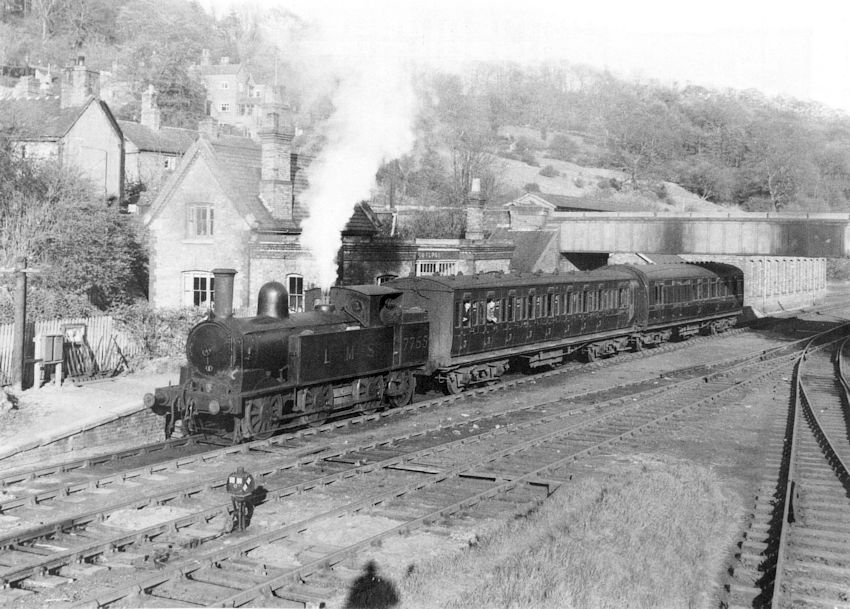
No. 7755 ex-LNWE coal tank at Coalport in 1948. The leading coach is LMS 7199. W. A. CAMWELL
COALPORT was developed as a 'new town' around 1794 largely in connection with the interchange of traffic between the River Severn and the eastern arm of the Shropshire Canal. This canal and its branches gave outlet to the products of the East Shropshire coalfield and its associated industries. The railway to Coalport came to be built, like others in Shropshire, largely as a result of competition with the cumbersome facilities then available on canals.
The Shropshire Union Canal and Railway Co., an amalgamation of several canal companies, was formed in July 1845, in the face of the railway mania threatening their joint futures. In the spirit of 'if you can't beat them, join them', the new company immediately proposed several railway schemes including a line from Shrewsbury to Stafford through Wellington. Its proposals were viewed by the then newly created London & North Western Railway Co. as a rival to their own interests in the area. In consequence the LNWR offered the Shropshire Union Co. a perpetual lease, which was authorised by an Act in June 1847. Other intense rivalries were growing up in this period for in 1846 an Act authorising a railway across the East Shropshire coalfield between Shrewsbury and Birmingham via Wolverhampton had been passed.
The section between Wellington and Shrewsbury was to be run jointly between the Shrewsbury and Birmingham Railway and the Shropshire Union Canal and Railway Co. (now of course controlled by the LNWR). The line opened in 1849 and in 1854 the S & BR was absorbed by the GWR and, although Wellington and Shrewsbury was now jointly operated by the GWR and LNWR, there was intense rivalry between both companies for the traffic generated by the East Shropshire industries.
The GWR spread eastward across the coalfield with various branches and in 1854 the LNWR finally woke up to the invasion when the GWR's Lightmoor branch threatened to take both long and short haul traffic from the Shropshire Canal, now under LNWR control.
The combination of the rival GWR branch and the poor condition of the canal eventually goaded the LNWR into action and in 1857 an Act was passed enabling the LNWR to build a railway to Coalport, closing parts of the canal and using its bed for the railway from west of Oakengates to the top of the old Windmill Hill inclined plane just south of Stirchley. From here an entirely new line was laid to Coalport. Under the principal engineer, John Errington, the line was built by two contractors, the first 2 miles 20 chains from the junction at Hadley, 'LNWR Shropshire Canal Contract No. 1', being undertaken by Daniel Climie (Contractor), Trinity Terrace, Shrewsbury under a contract dated 18th August 1858. All civil engineering was to be completed as for a double line, although single line was actually laid. Rails, chairs and sleepers were to be provided by the LNWR, the contractors providing rails and sleepers for temporary construction.
Contract No. 2 for a railway the remainder of the distance to Coalport, was drawn up with a different contractor, George Meakin of Birkenhead. Both Contract No. 1 and the first 2 miles 2 chains of Contract No. 2 were to be completed by 1st August 1859 and the remaining stretch to the terminus by 31st December 1859. The contractors were also requested to construct and maintain reservoirs for supplying water to local ironworks and to complete these before drawing water off the canal.
In the event, the Coalport branch was not opened by the LNWR until 10th June 1861.
Very much a goods line, the 7¾ mile route abounded with private sidings to the extent that twenty-four diagrams were issued at different times by the LNWR and later the LMS to document the various siding interconnections along the way.
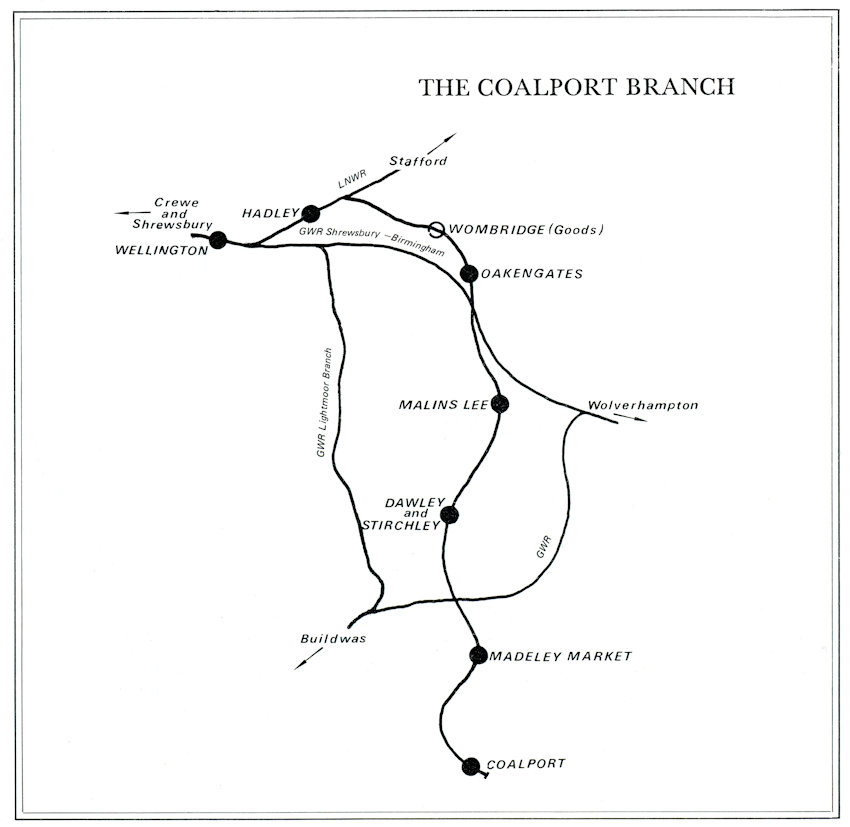
Shortly after leaving Hadley Junction on a down gradient, the line began to climb up towards Oakengates and between mileposts ¼ and ½, just under one mile from Hadley Junction, the first large private siding was encountered at Wombridge.
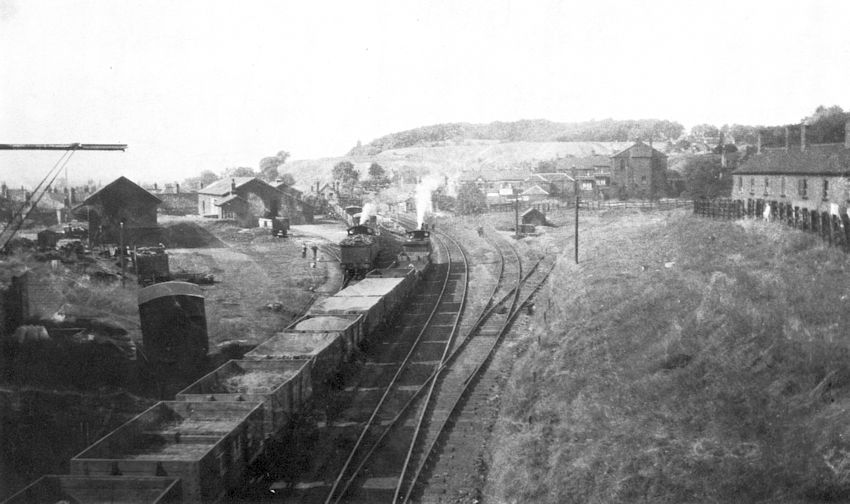
Oakengates in the 1930s with a goods train hauled by an unidentified 0‒6‒0 passing a Super D 0‒8‒0 waiting in the goods yard. The very sharp curve just apparent on the extreme left is Millington’s timber yard siding. The shed on the left was latterly used by the CWS as a store. C. L. MOWAT
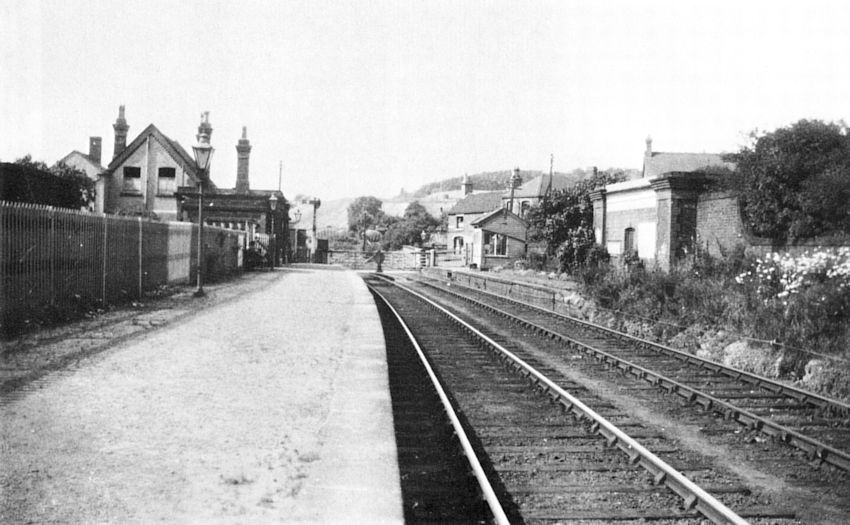
Oakengates, looking towards Hadley Junction c.1930. C. L. MOWAT
Oakengates station, reached after a climb out of Wombridge up a 1 in 50 gradient, was situated adjacent to a level crossing and provided with two platforms. South of the station was a double private siding interchange for Snedshill Ironworks and Priors Lee Furnaces, part of the great Lilleshall Company's industrial complex. The Lilleshall Company possessed its own private standard gauge railway system, well documented in the Industrial Railway Society's Handbook G, which lists twenty-two locos known to have served the Lilleshall Company.
Passing over the old Shrewsbury and Birmingham Railway, which built its own station at Oakengates, the line reached Hollinswood, where it ran parallel to the original S & B main line, both routes having interchange with the Eagle Iron Works, Hollinswood. The LNWR also had an agreement with the Old Park Co. for a siding known as the Pudley Hill Siding situated opposite the entrance to the Eagle Iron Works.
The climb for down trains finished hereabouts and Malins Lee station was approached on the level under one of several tramway overbridges. The land-scape of the district, known locally as Dark Lane rather than Malins Lee, was dotted with collieries, spoil tips and the Dark Lane foundry which was visible from passing trains.
Botfield's Siding, south of the Malins Lee station, was a reminder of the great part played by the Botfield family in the development of the iron and coal industries of East Shropshire. A diagram showing the addition of a ballast siding for use by the LNWR shows the sidings as belonging to the Stirchley Iron and Coal Co. Another private siding nearby served Old Park Company, an enterprise also built up by the Botfields.
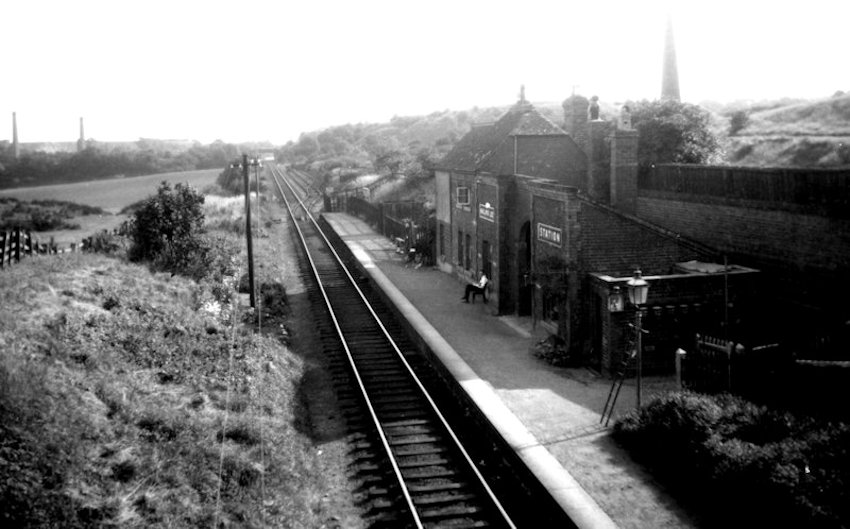
Malins Lee station in 1932. The railway here was built on the site of the old canal. and the station house. unlike the others in design. may well date from that time. Dark Lane Foundry and the area of small collieries were served by a siding on the right . Malins Lee was closed between January 1917 and February 1919 due to wartime economy and was finally closed in 1952 before the other stations. L & GRP, COURTESY DAVID & CHARLES

Malins Lee station in 1954 after closure. AUTHOR'S COLLECTION
At Old Park the LNWR were in very close proximity to their rivals, the GWR, whose Old Park or Stirchley branch connected into the eastern entrance to the Old Park works. The GWR also tapped the traffic from the Randley Brickworks further south, although the LNWR did have some share of this according to a plan attached to an agreement dated 1896 showing a loop with a loading bay and a tramway connection 545 yards south of Malins Lee station. Later this tramway must have been converted to standard gauge track for a photograph in Telford, then & now shows an LNWR 0‒6‒0 shunting on a siding on the line of the old tramway shown on the diagram.
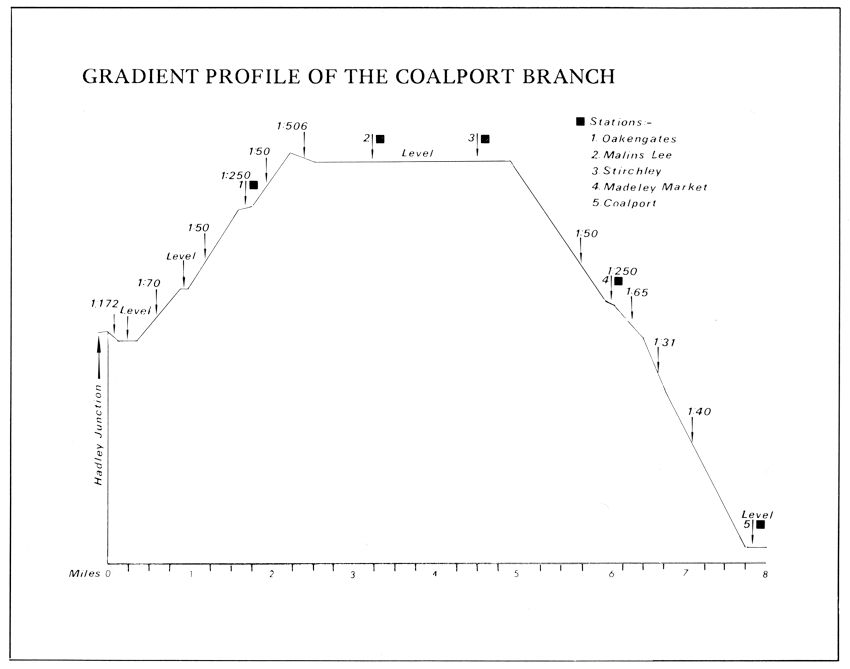
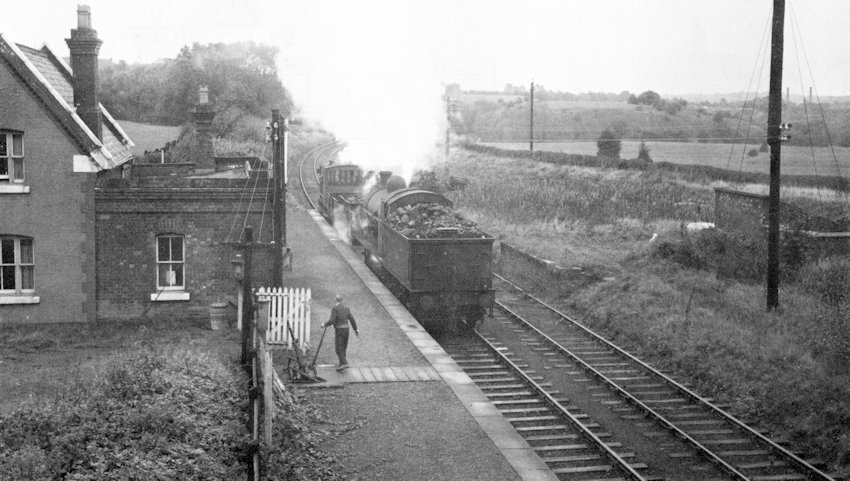
Dawley and Stirchley station in 1932. The addition of Dawley to the station name was carried out by the LMS in 1923. L & GRP, CTY. DAVID & CHARLES
The branch continued on the level towards Stirchley station, past the collieries and ironworks which lay to the west, served by rail networks, one of which connected into Stirchley station. A siding, 39 chains north of Stirchley station, served the Haybridge Iron Co's Hinkshay Pits, whilst another up to the northern end of Stirchley station was probably part of the system which belonged to the Wellington Iron & Coal Co. Ltd., referred to in the IRS Hand-book G.

Dawley and Stirchley in April 1955. J. PRITCHETT
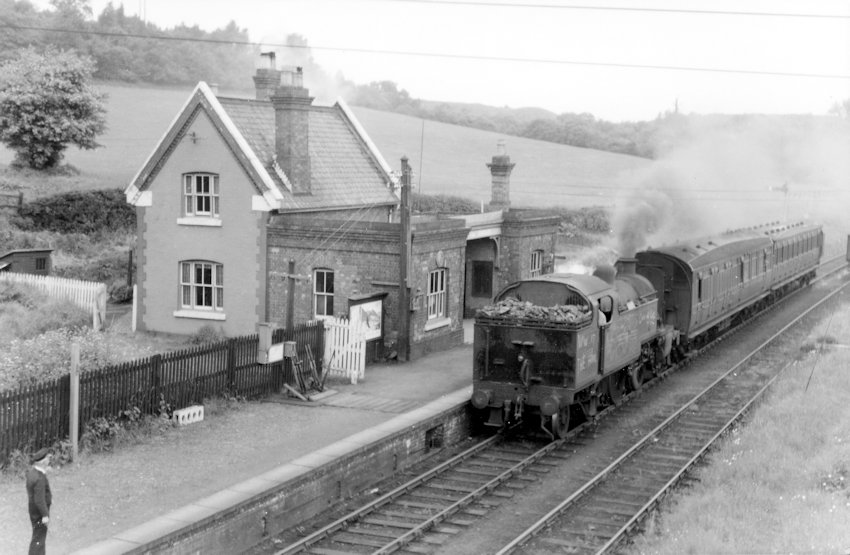
Dawley and Stirchley with Fowler tank No. 40058 bearing chalked farewell messages on the Wellington-Coalport train on 31st May 1952, the last day of passenger services. AUTHOR'S COLLECTION
On from Stirchley the descent towards Coalport began. Before reaching Madeley Market station, the LNWR crossed the GWR's Coalbrookdale branch close to the GWR's Madeley station. Having left the bed of the old Shropshire Canal, the railway swung through Madeley Market on a curve and on down towards Coalport. The line's notorious 1 in 31 gradient began at milepost 6½ then eased after a quarter of a mile past yet another private siding serving the Madeley Company.
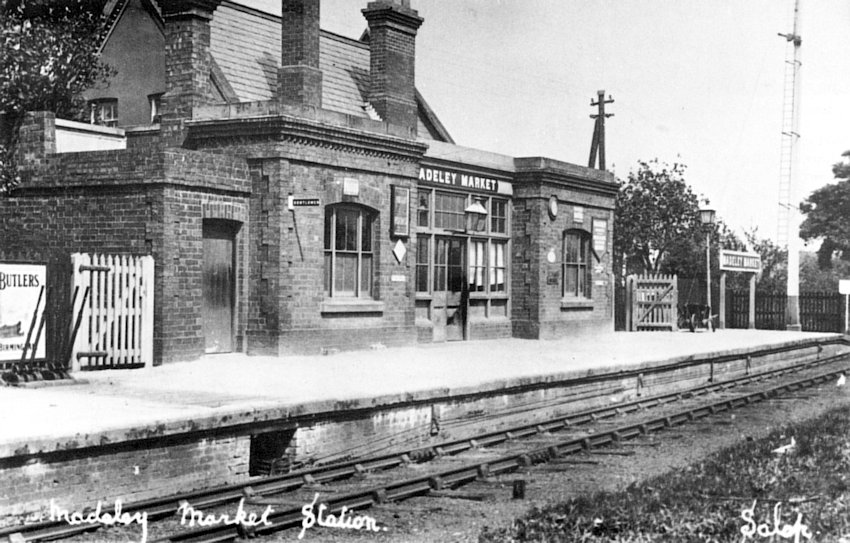
An Edwardian postcard of Madeley Market after the station had been singled and the shelter removed from the opposite platform. AUTHOR'S COLLECTION
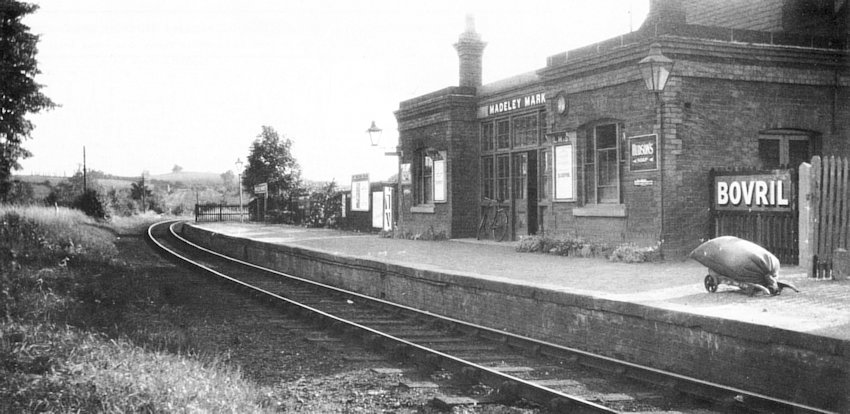
Madeley Market in 1932. L & GRP, CTY. DAVID & CHARLES
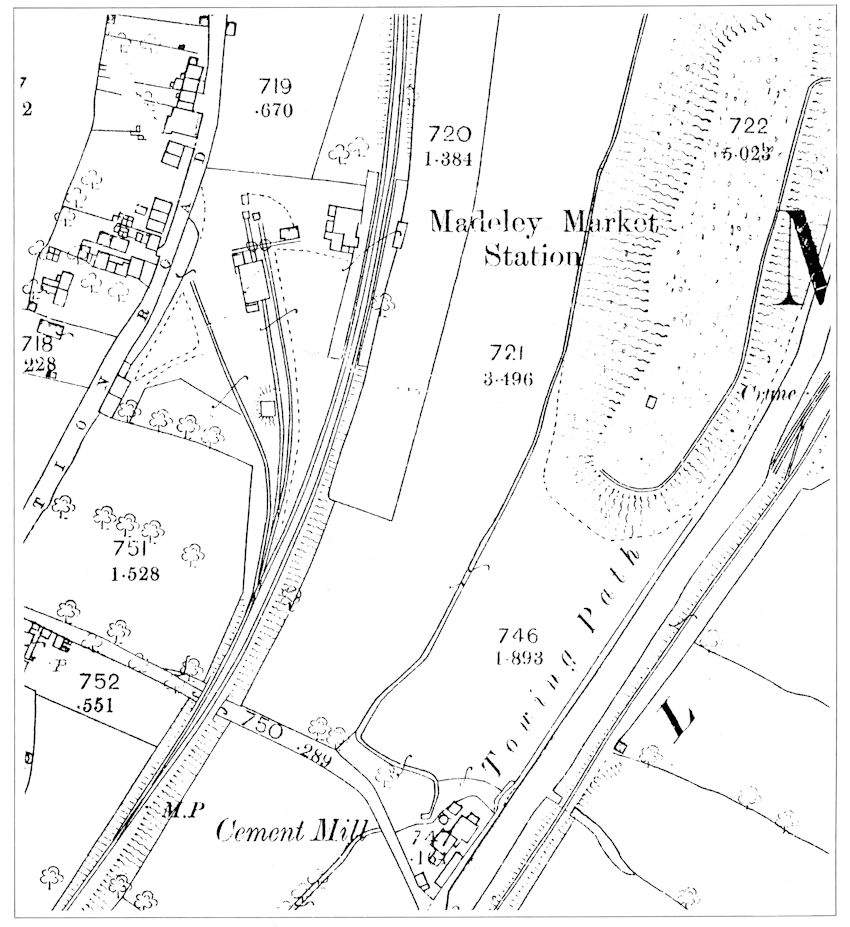
Taken from 25 inch Ordnance Survey for 1883. Crown Copyright reserved.
The final mile into Coalport took the railway through a short tunnel built through the brickwork of the Hay inclined plane once used to exchange vessels between the Shropshire Canal and the River Severn below. This busy waterway exchange and the siting of the Coalport china factory formed the foundation for the growth of William Reynold's new town. The china factory siding, 23 chains north of Coalport, was the last private siding before entering the terminus.

Down goods between Madeley and Coalport, seen from the top of Coalport down distant on 14th Aprit.1955. J. PRITCHETT
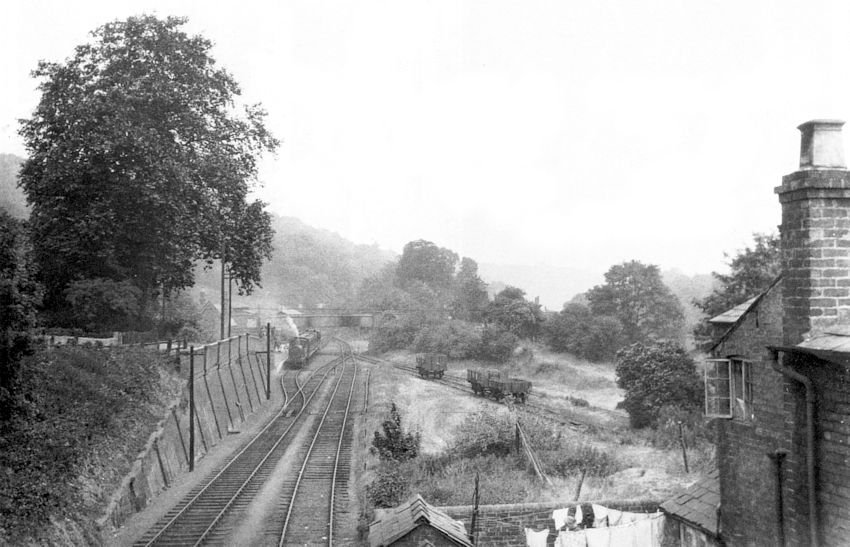
An unidentified coal tank prepares to tackle the 1 in 40 climb out of Coalport on 19th July 1941. In the 1930s one of the sidings to the right, leading to the old canal warehouse, had been used to stable the LMS caravan. R. E. TUSTIN
In an article recording a journey over the line in 1889, T. R. Perkins recalls being hauled by an 0‒6‒0ST without a cab, the train consisting of 'three or four 4 wheelers of decidedly antique type being open from end to end, cushioned only on the seats and lighted with oil lamps. No continuous brakes were fitted to either locomotives or carriage.' In a year or so, records Mr. Perkins, the old train was replaced by one with continuous brakes hauled by a 2‒4‒2T.

Coalport goods yard from across the River Severn with a 17in. 0‒6‒0 goods loco in view. The goods shed on the left is a conversion of a Shropshire Canal Co, building. This picture shows the station before the waiting room area was enclosed with glass panelling. SHROPSHIRE COUNTY LIBRARY

Coalport trackplan as featured on 25 inch Ordnance Survey for 1883. Crown Copyright reserved.
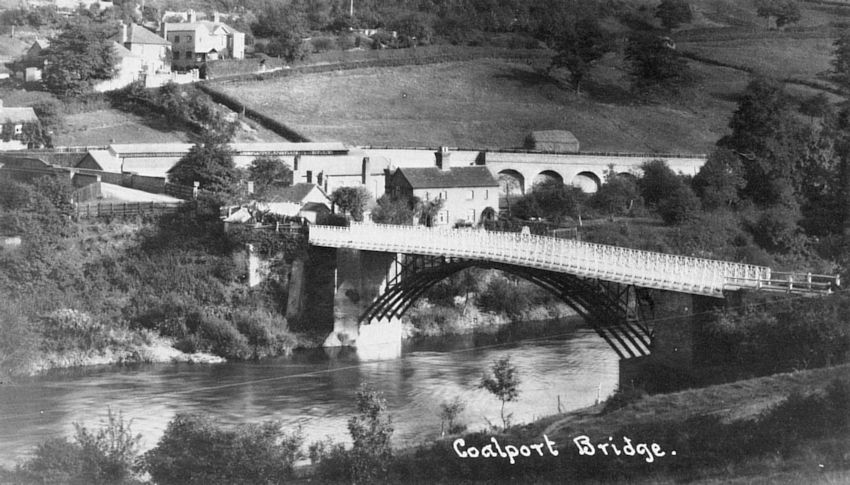
Old postcard view showing the Coalport bridge over the Severn. This structure was a complex mixture of parts added at different times, the earliest dating back to c.1780. Much of it is in early 19th century cast iron. The roofs of the carriage and engine sheds are clearly visible. AUTHOR'S COLLECTION

The bridge carrying the road into Coalport, with an unidentified locomotive running round its train. NATIONAL RAILWAY MUSEUM

Coalport 1932 with groundframe visible at the end of the platform. L & GRP, CTY. DAVID & CHARLES
The Working Timetable for May 1905 shows the line worked by two engines, both of which were required to haul traffic over the gradient between Madeley wood siding and Stirchley and also indicates four staff stations.
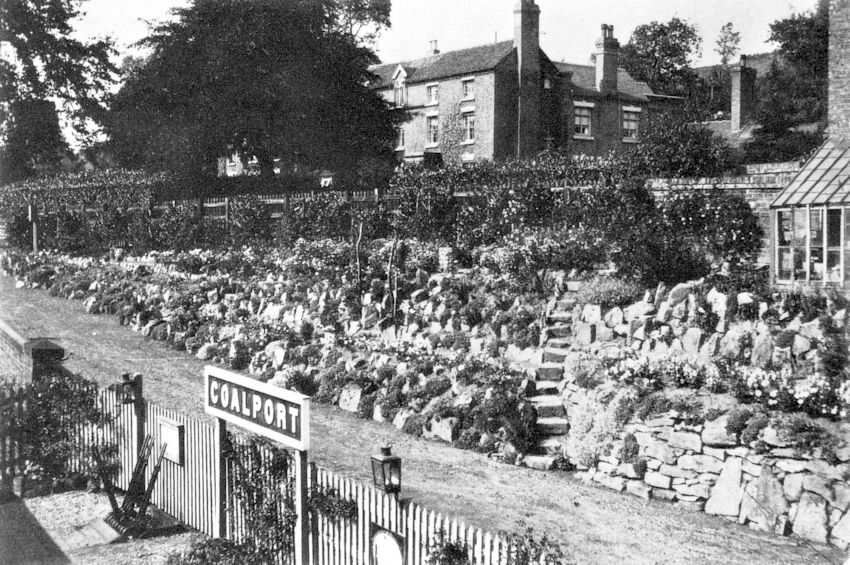
The station staff were proud of their achievement in winning the best kept garden in the division in 1929. AUTHOR'S COLLECTION
A two-coach motor train worked the branch from May 1910 until some time after the grouping, with 50 ft x 8 ft arc roof stock (converted from ordinary non-corridor). By this time the branch was third class only, one coach was an eight compartment third to Diagram D289, No. 103 (LMS No. 5345), and the other was a driving trailer to Diagram M59, No. 1815 (LMS No. 5338).
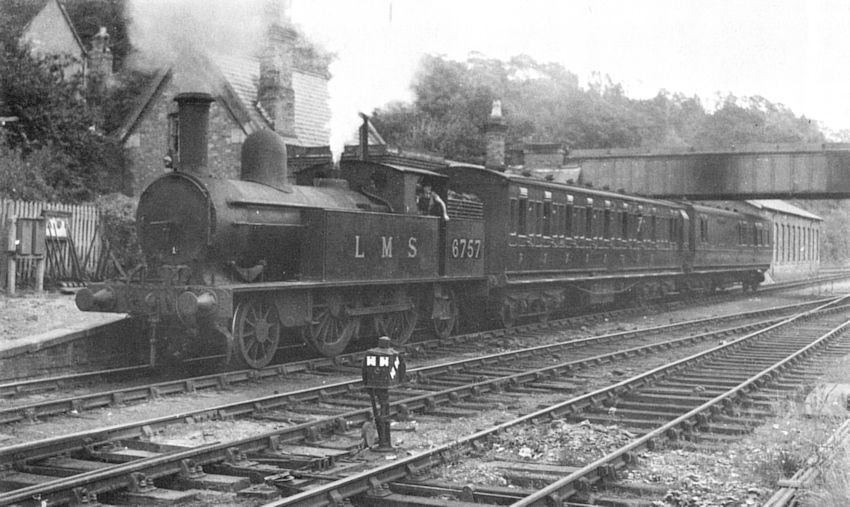
Webb 2‒4‒2T No. 6757 at Coalport in 1948. W. A. CAMWELL

LMS holiday caravan believed to be on the back siding at Coalport. AUTHOR'S COLLECTION
Details of locomotives working the line are hazy but as Coalport was a sub-shed of Shrewsbury (LNWR No. 30), the 1917 allocation of the latter at least provides a clue. Only one, however, is confirmed by an eye-witness and that is the 4ft 6in 2‒4‒0 LNWR No. 1000. 0‒6‒2T 'Coal tanks', LNWR Nos. 119, 292, 2459 and 5ft 6in 2‒4‒2T LNWR No. 1157 were allocated to Shrewsbury in 1917 along with 17in Goods 0‒6‒0s 1713, 2437, to mention a few possibilities.
In the 1920s an additional private siding known as Legge's siding, was put in between Madeley Market and Coalport but the Coalport china factory's move to Stoke-on-Trent dealt a major blow to the district's economy. The factory and siding were taken over by a firm called 'Nu-Way', manufacturers of rubber mats, in 1928.
Goods traffic between the wars must have produced a predominance of open wagons with many 'private owners' from the coalfields and the Cornish china clay pits - at least until the removal of the Coalport china factory. 'North and Rose' and 'St. Austell China Clay Co' are two such wagons noted from photographs. 'Lilleshall' and 'Madeley Wood Co' were locals, as was the 'Mid-Shropshire Coal Co, Coalport' of which I would like to know more. Movement of wagons to and from the Staffordshire and Shropshire Coalfields would be expected and indeed, following a check on some post-war wagon labels from the branch, consignments from Littleton, Baggeridge, Donnington and Rugeley Collieries were confirmed.
From time to time the occasional excursion was run over the branch and an interesting vehicle kept at Coalport in the 1930s was camping coach ('caravan' in LMS language) No. 46020 an ex-corridor third which was popular with holiday makers. It was sited on a back road in the goods yard overlooking the River Severn.
During the war passenger services were reduced and the branch provided storage sites for ammunition and special trains were observed hauled by Stanier Class 5 4‒6‒0s.
By 1947 a full timetable was reinstated and nationalisation the following year at first brought little change. The 'Dodger', as it was popularly known, was still hauled by the 0‒6‒2T coal tanks and there was still ex-LNWR 2‒4‒2Ts Nos. 46601 and 46757 around in 1949 and 1950 as a reminder of past days. However, in December 1949 Wellington shed received its first allocation of Fowler 2‒6‒2Ts (40005 and 40006) and these took over much of the passenger work. Now one coach rather than two seemed to be sufficient to cope with the public demand. Ivor Brown, who travelled to school at Oakengates from Madeley Market in 1950, recalls reading a faded notice left over from the wartime, 'Is your journey really necessary?' He remembers Madeley Market was then manned by a staff of three. In country tradition either station master Mott or porter Redding would hold the train up if any of the regular complement of seven travellers had not appeared on time for their train, but unfortunately, sometimes it was the train itself which failed to turn up, and Mr. Brown recalls an increasing number of occasions when a Midland Red bus had to be used as substitute. Even the increased traffic on a market day (Thurs- day) returning from Wellington Market could not save the passenger service and the rumour of imminent closure took Mr. T. R. Perkins back for a nostalgic journey in 1951. He, too, commented upon the lack of passengers on the one coach he joined hauled by Fowler 2‒6‒2T 40058. Rumour became fact and it was 40058 which hauled the final regular passenger train over the branch on 31st May 1952. Malins Lee station was also closed completely from this time.

Coal Tank No. 58926 taking water at Coalport on 21st October 1950. HAROLD BOWTELL
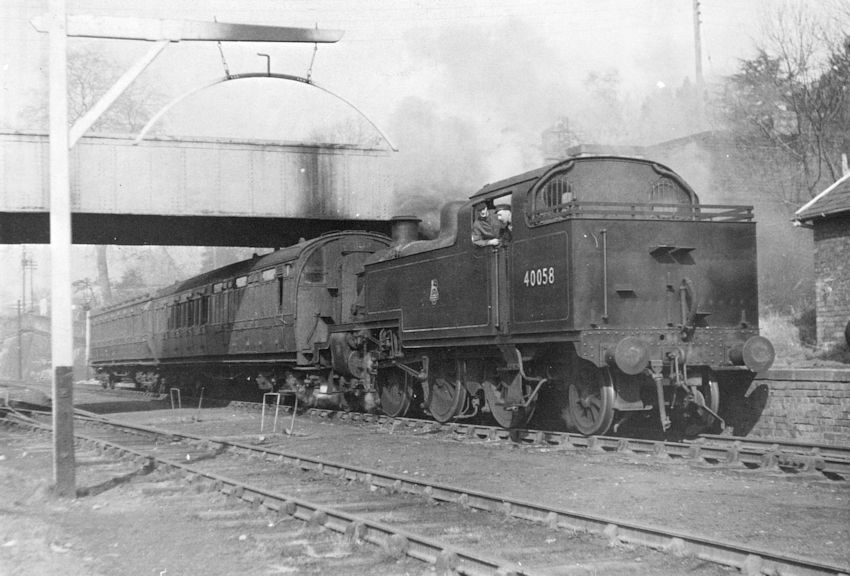
Fowler 2‒6‒2T No. 40058 at Coalport on 18th March 1952. The second coach M22640 was built by joining two 28 ft 4-wheeled vehicles on a new underframe to become an arc-roofed brake third, Diagram 3338 of 1921. On odd occasions Stanier 2‒6‒4Ts deputised on branch duties and 'Crab' 2‒6‒0s and Stanier Black 5s appeared on excursions to Blackpool. F. W. SHUTTLEWORTH
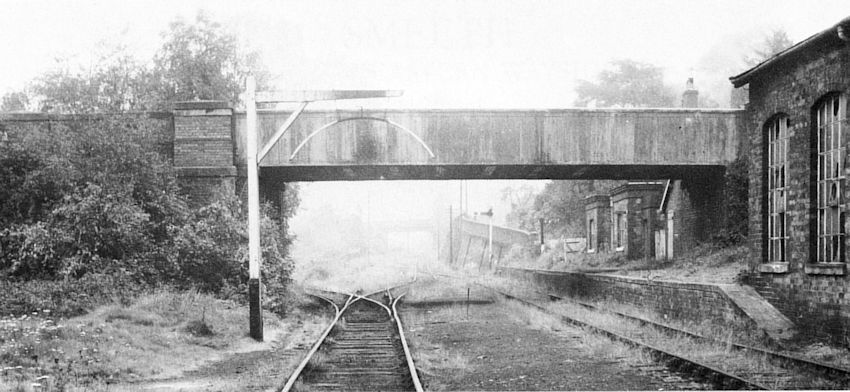
A sad scene taken in September 1957. AUTHOR'S COLLECTION
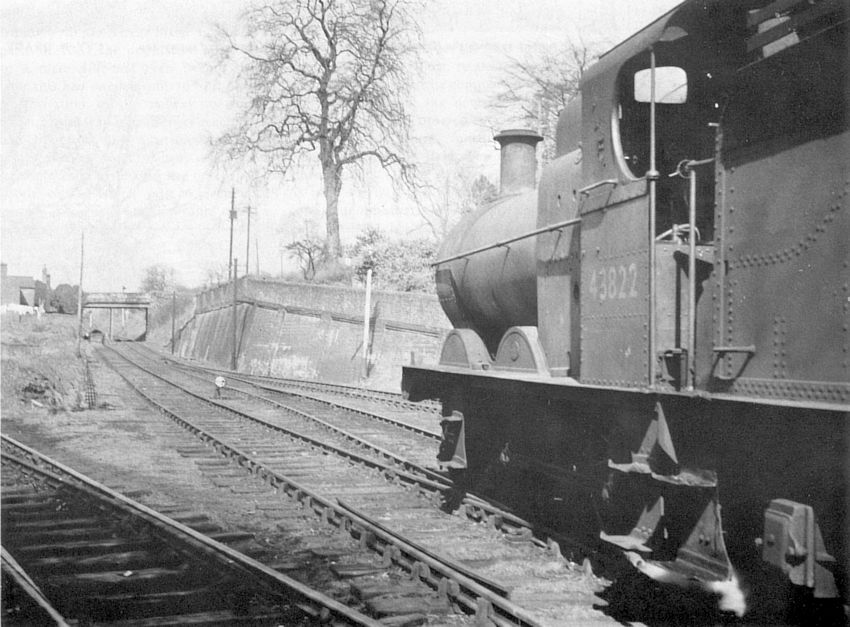
Ex-MR 0‒6‒0s appeared in the mid-1950s after the goods service declined. No. 43822 is shown here on local goods at Coalport on 13th April 1955. J. PRITCHETT
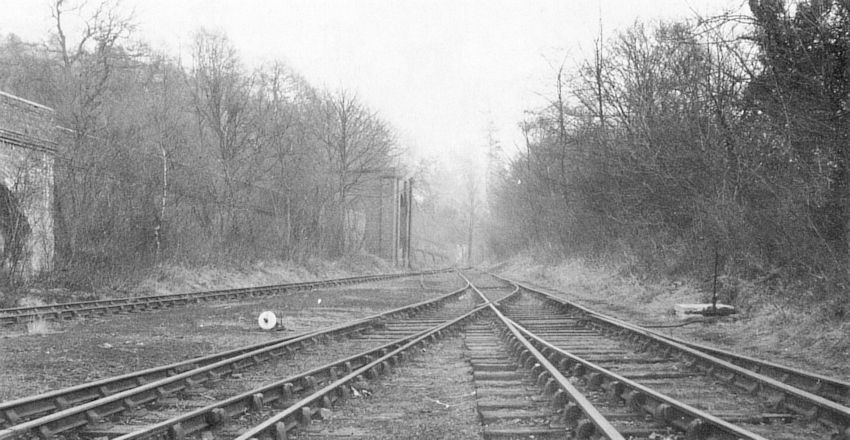
Looking towards the buffers after removal of the water tank. 19th March 1955. F. W. SHUTTLEWORTH
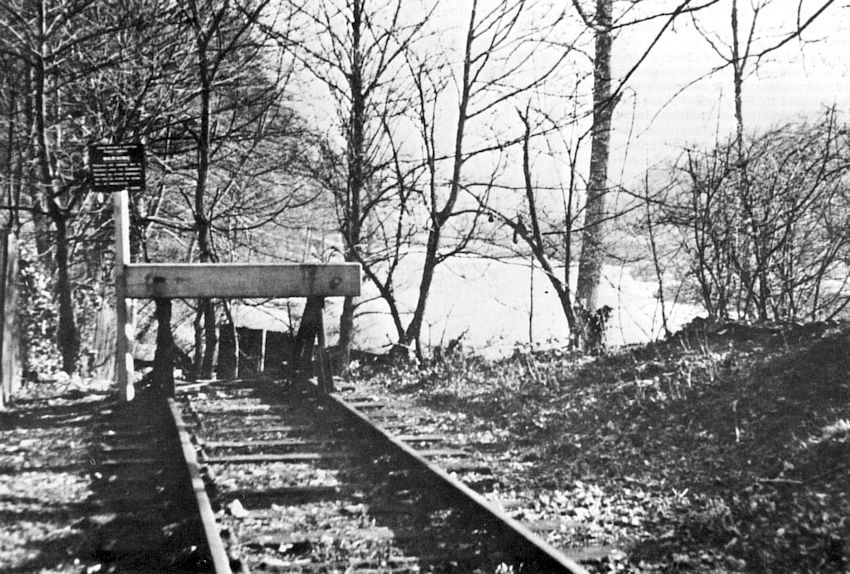
The end of the line above the River Severn. NATIONAL RAILWAY MUSEUM
In May 1953 the 0‒6‒2T Coal Tanks were withdrawn from the Shrewsbury shed and ex-Midland 2F 0‒6‒0s began to appear on Coalport goods trains. Soon afterwards control of the line passed to the Western Region and Coalport became known as Coalport 'East', supplies of stores now arriving from Swindon.
By now the goods service was rarely required at Coalport East as John Browning, depot clerk at Oakengates West in the 1958-62 period, recalls. He dealt with matters at both former LNWR (now Market Street) and GWR (now West) stations. The morning train from Shrewsbury (Coton Hill) would shunt the 'coal road' at Oakengates, removing empties and placing the loaded coal wagons for the merchants, CWS Ltd. and Messrs. W. Upton & Son. The goods shed was in use as a store for fertilizer and scrap was loaded at two wharves in the yard. Coke was brought in for John Maddocks, Oakengates from Tonyrefail.
Mr. Browning recollects that traffic from Lilleshall Co. had ceased by this time and so it came as no surprise to find the section from Stirchley to Coalport was closed in December 1960. The rest of the line lingered on, with W. P. Watkins & Co. Ltd. still receiving coal at Dawley and Stirchley, but in 1964 the remnant of the branch was deemed to have no further use and on 6th July it was finally laid to rest.
In conclusion, I would like to put on record that this article would not have been possible without the kind assistance of Mr. John Pritchett. I would also like to acknowledge the help from various members of the HMRS and LNWR Societies.
